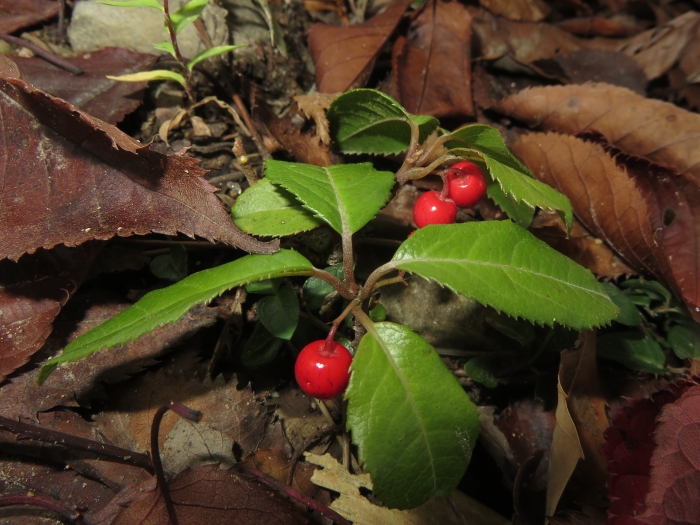Marlberry
(Ardisia japonica)
Marlberry (Ardisia japonica)
/
/

Qwert1234
CC BY-SA 4.0
Image By:
Qwert1234
Recorded By:
Copyright:
CC BY-SA 4.0
Copyright Notice:
Photo by: Qwert1234 | License Type: CC BY-SA 4.0 | License URL: https://creativecommons.org/licenses/by-sa/4.0 | Uploader: Qwert1234 | Publisher: Wikimedia Commons | Title: Ardisia_japonica_3.JPG | Notes: Uploaded own work with UploadWizard |















Estimated Native Range
Summary
Ardisia japonica, commonly known as Marlberry, is an evergreen subshrub native to the understory of forests and woodland areas in East Asia, particularly Japan, Korea, Taiwan, and China. It typically grows to a height of 20–40 cm with a spreading habit. The leaves are glossy, dark green, ovate, 4–7 cm long, and 1.5–4 cm broad, with a sharply serrated margin and an acute apex. Marlberry produces small clusters of fragrant, white to pale pink flowers, each 4–10 mm in diameter, blooming in racemes in late spring. The flowers are somewhat showy due to their abundance. After flowering, it bears red drupes that are attractive to birds.
Marlberry is valued for its shade tolerance and is often used as a ground cover in woodland gardens, shaded borders, or as an understory plant in larger landscapes. It is also appreciated for its evergreen foliage, which provides year-round interest. In cultivation, it requires part shade to full shade, consistent medium moisture, and well-drained soils. While it is not particularly drought-tolerant, it can adapt to a range of soil conditions. Gardeners should be cautious as Ardisia japonica can become invasive outside its native range, particularly in regions like Florida. It is recommended to check local regulations and avoid planting in areas where it may spread uncontrollably.CC BY-SA 4.0
Marlberry is valued for its shade tolerance and is often used as a ground cover in woodland gardens, shaded borders, or as an understory plant in larger landscapes. It is also appreciated for its evergreen foliage, which provides year-round interest. In cultivation, it requires part shade to full shade, consistent medium moisture, and well-drained soils. While it is not particularly drought-tolerant, it can adapt to a range of soil conditions. Gardeners should be cautious as Ardisia japonica can become invasive outside its native range, particularly in regions like Florida. It is recommended to check local regulations and avoid planting in areas where it may spread uncontrollably.CC BY-SA 4.0
Plant Description
- Plant Type: Shrub
- Height: 0.5-1 feet
- Width: 1-3 feet
- Growth Rate: Moderate
- Flower Color: Pink, White
- Flowering Season: Summer, Fall
- Leaf Retention: Evergreen
Growth Requirements
- Sun: Part Shade, Full Shade
- Water: Medium
- Drainage: Slow, Medium, Fast
Common Uses
Border Plant, Deer Resistant, Groundcover, Hedges, Potted Plant, Street Planting
Natural Habitat
native to the understory of forests and woodland areas in East Asia, particularly Japan, Korea, Taiwan, and China
Other Names
Common Names: Japanese Ardisia, 자금우
Scientific Names: , Ardisia japonica, Bladhia japonica, Ardisia glabra, Bladhia japonica f. leucocarpa, Tinus japonica,
GBIF Accepted Name: Ardisia japonica (Thunb.) Blume